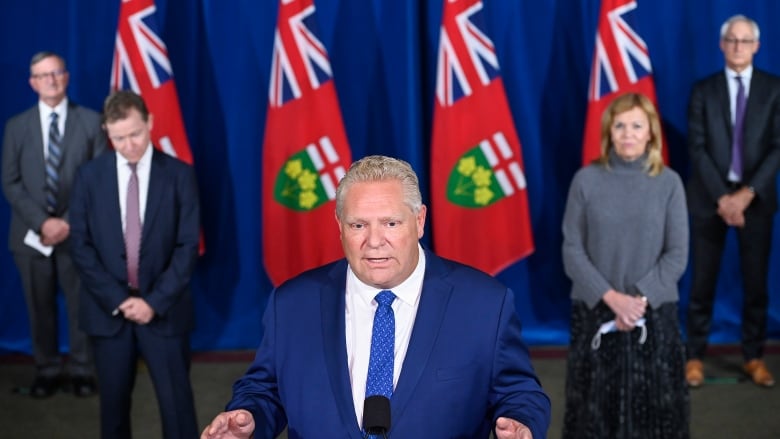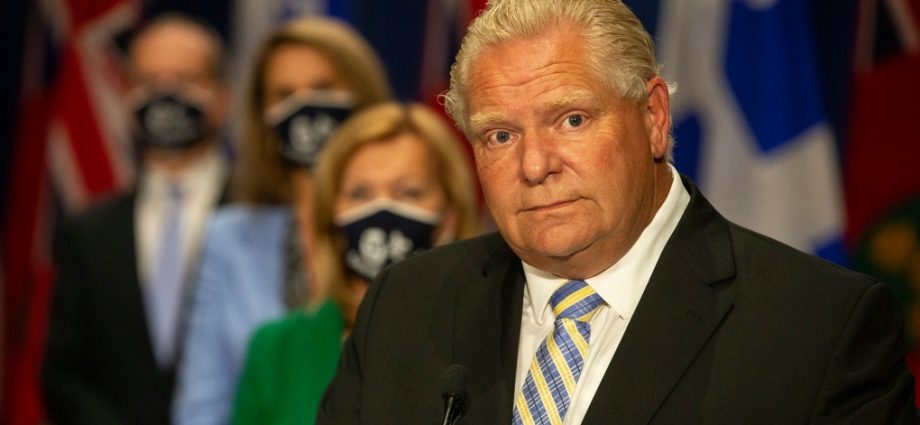Toronto, Ottawa, Peel Region moving to modified Stage 2 restrictions for at least 28 days

THE LATEST:
- Ontario is implementing targeted temporary measures in Ottawa, Toronto and Peel Region by moving them into modified Stage 2 restrictions for a period of at least 28 days.
- The measures, which go into effect at 12:01 a.m. Saturday, include prohibiting indoor dining, and closing gyms, cinemas, casinos, performing arts and racing venues.
- Schools, child-care centres and places of worship will remain open. Before-school and after-school programs will also be exempt from the new restrictions.
- Personal care services where masks must be removed are prohibited, as are team sports games and scrimmages.
- Capacity limits are reduced to 10 people indoors for tours, real estate open houses and meeting and event spaces. Physical distancing must be maintained.
- Wedding receptions will be limited to 10 people indoors or 25 people outdoors effective Oct. 13.
- The government is also asking people in those areas to only leave their homes for essential purposes. Travel to other regions in the provinces should also be limited (though there is no outright travel restriction in place).
Ontario is imposing stricter measures in Toronto, Ottawa and Peel Region in a bid to curb the spread of COVID-19 as the province’s curve climbs ever steeper.
The measures, which go into effect Saturday for a period of 28 days, include prohibiting indoor dining at restaurants and bars, and closing gyms, movie theatres and casinos. After that, the province’s health experts will review the measures.
The government is also asking people in those areas to only leave their homes for essential purposes. Schools and child-care centres will remain open as part of the plan.
“All trends are going in the wrong direction,” said Premier Doug Ford at a news conference Friday, saying the pandemic has picked up speed at “an alarming rate.” Ford added that if current trends continue, hospitals could be overwhelmed with intensive-care unit placements tripling in less than 30 days.
“If we don’t take action now, the situation could overtake us,” said Health Minister Christine Elliott.
The new restrictions come as Ontario marked a record 939 new cases of COVID-19 on Friday, most of them in Toronto, Ottawa and Peel Region. Those regions have consistently reported the majority of new cases in recent weeks.
Ford said the measures were decided on after the province’s top doctors provided “brand new data” to justify new restrictions — although critics have been calling for a rollback to stricter measures for several weeks.
On Friday, the province shared a document from its COVID-19 science table that it said provides the evidence that informed the decision to take stricter measures in the three regions. See it for yourself at the bottom of this story.
Asked why the province didn’t act sooner despite the calls of many doctors and health professionals, Ford said he took his direction from the province’s health table, and said the recent surge was a sudden one. That’s despite Ontario’s own modelling forecasting 1,000 cases by mid-October more than a week ago.
“I made a decisive decision to act immediately,” he said. “If I didn’t make this decision now, I would be negligent.”
Ford again defended provincial Chief Medical Officer of Health Dr. David Williams on Friday after criticism surfaced about mixed messaging when it comes to public health. But the premier acknowledged that while Williams was at the helm when Ontario brought its new COVID-19 cases down to under 100, perhaps the government loosened its grip on the virus too soon.
“All of us, maybe even the government, maybe we got too lackadaisical when we saw 80 cases with a population of 14.5 million people…. It came back to bite us, as we all went out there and now we have to tighten it up,” he said.
However, a return to the further restrictions of Stage 1, he said, would be an “economic disaster.”
Ford also spoke directly to business owners, announcing $300 million to support businesses amid the closures.
Asked when the province might consider shutting down schools, Williams said there hasn’t been evidence of a lot of transmission within schools as yet. In many cases, the virus has entered schools from outside the community, he said, but that hasn’t happened in a uniform way across the province.
A large-scale shut down of schools is “not merited at this time,” he said.
‘Worst-case scenarios’ could mirror those in Italy, New York
The government said if current trends continue, the province could experience “worst-case scenarios” seen in northern Italy and New York City earlier in the pandemic.
Williams said the sharp increase in daily case numbers was very concerning and action was required, particularly in settings where mask-wearing and physical distancing is more difficult.
Williams said the new measures will take the three hot spot regions back to a “modified Stage 2” of the province’s pandemic response plan, which saw restrictions on non-essential businesses earlier this year.
He said that if people return to following public health guidelines well, the province can once again flatten the curve.
“We’ve done this before. I think we can do it again,” he said.
Targeted action could prevent province-wide restrictions
Dr. Adalsteinn Brown, who is advising the province on its pandemic response, said taking the targeted action could prevent broader province-wide restrictions down the road.
“Jurisdictions that are intervening early are getting better control of the pandemic,” he said.
Ontario reported its highest-ever daily number of new cases on Friday.
It is also the second day in a row the province is seeing record-breaking daily figures after reporting 797 cases Thursday. Doctors are also sounding the alarm about an increased number of COVID-19 patients being admitted to intensive care units.
Toronto, Peel and Ottawa continue to account for the majority of the province’s daily figures, with 336, 150 and 126 cases respectively, Elliott said in a series of tweets.
Other areas that saw double-digit increases include:
- Halton Region: 59
- Simcoe-Muskoka: 28
- Durham Region: 32
- Hamilton: 40
- Middlesex-London: 24
- Waterloo Region: 13
- York Region: 68
- Windsor-Essex: 18
- Niagara Region: 10
- Wellington-Dufferin-Guelph: 16
Friday’s update brings the province’s total to 57,681 cases of the virus since the outbreak began in late January.
There are 225 patients currently hospitalized in Ontario, a significant increase from yesterday’s figure of 206.
An additional 724 cases of COVID-19 are now considered resolved, bringing the province’s total number of resolved cases to 49,032.
Toronto Mayor John Tory called the recent surge in numbers “troubling.”
“The status quo is not acceptable,” he said on CBC Radio’s Metro Morning on Friday.
Toronto’s Medical Officer of Health Dr. Eileen de Villa asked the province last week to order a 28-day closure of indoor service at restaurants, as well as indoor fitness and recreation facilities, to try to rein in the spread of COVID-19 in the city.
Under strain
This all comes with many hospitals in the province filled to capacity and intensive care units in some Greater Toronto Area hospitals reporting few available beds.
The Ontario Hospital Association also urged the province to put the GTA and Ottawa back to Stage 2.
The province’s COVID-19 testing system is also under strain, with appointments at assessment centres in the hardest-hit areas being snapped up shortly after they become available, and some people having to wait days to get tested. The Ministry of Health last week changed the criteria to get a test, limiting eligibility primarily to people with symptoms of COVID-19 or those who’ve been exposed to a confirmed case.
Nearly one-tenth of Ontario’s 4,800 publicly funded schools have reported cases of COVID-19, and a similar proportion of the 630 long-term care homes in the province are battling outbreaks of the coronavirus.
reference:https://www.cbc.ca/news/canada/toronto/covid-19-ontario-cases-friday-1.5756516

